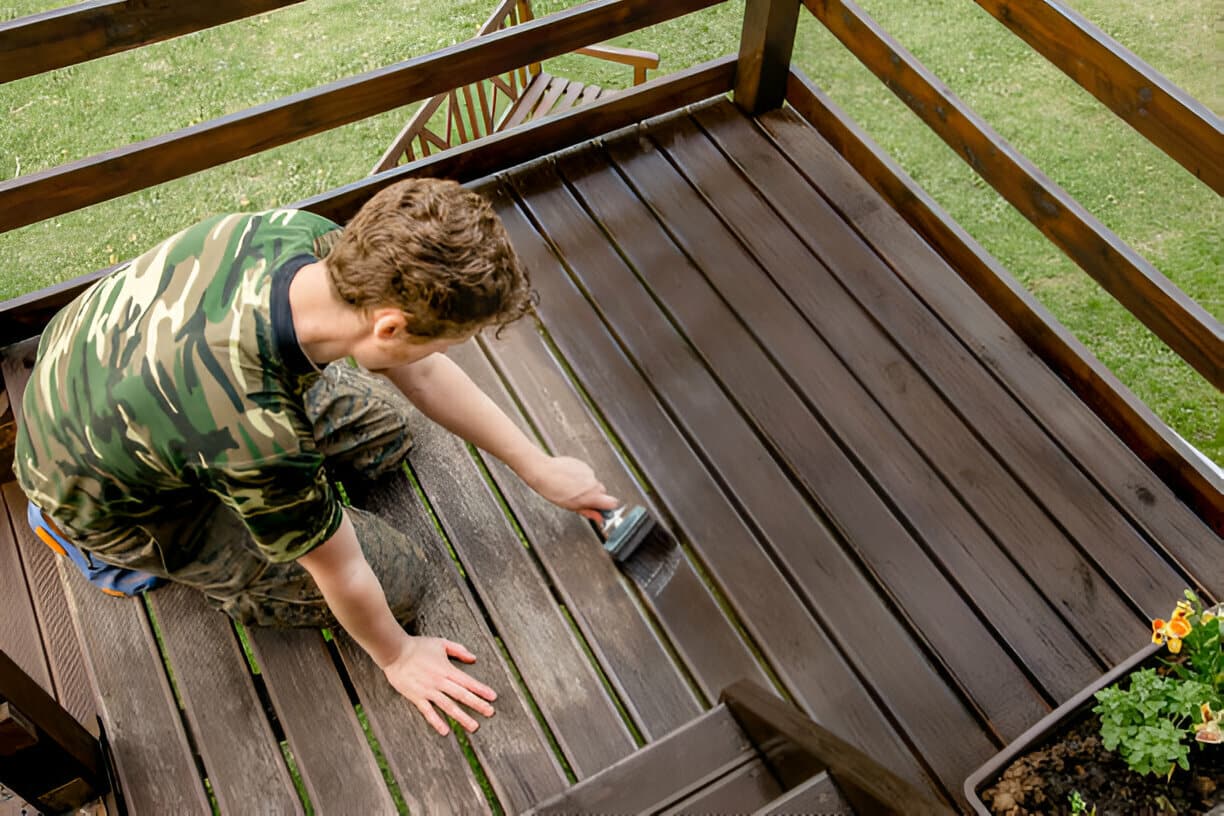Your deck is more than just an outdoor structure—it’s an extension of your home, your style, and your lifestyle. Whether you’re hosting summer barbecues, sipping coffee at sunrise, or relaxing with a book, your deck deserves the kind of attention that brings out its best. That’s where the power of a quality deck stain comes in.
In this guide, we’re diving deep into everything you need to know about deck staining—from choosing the best deck stain and sealer, selecting colors, and understanding stain types to expert tips on how to stain a deck for long-lasting results. Let’s turn your weathered wood into a beautifully restored retreat.
Why Deck Staining Matters
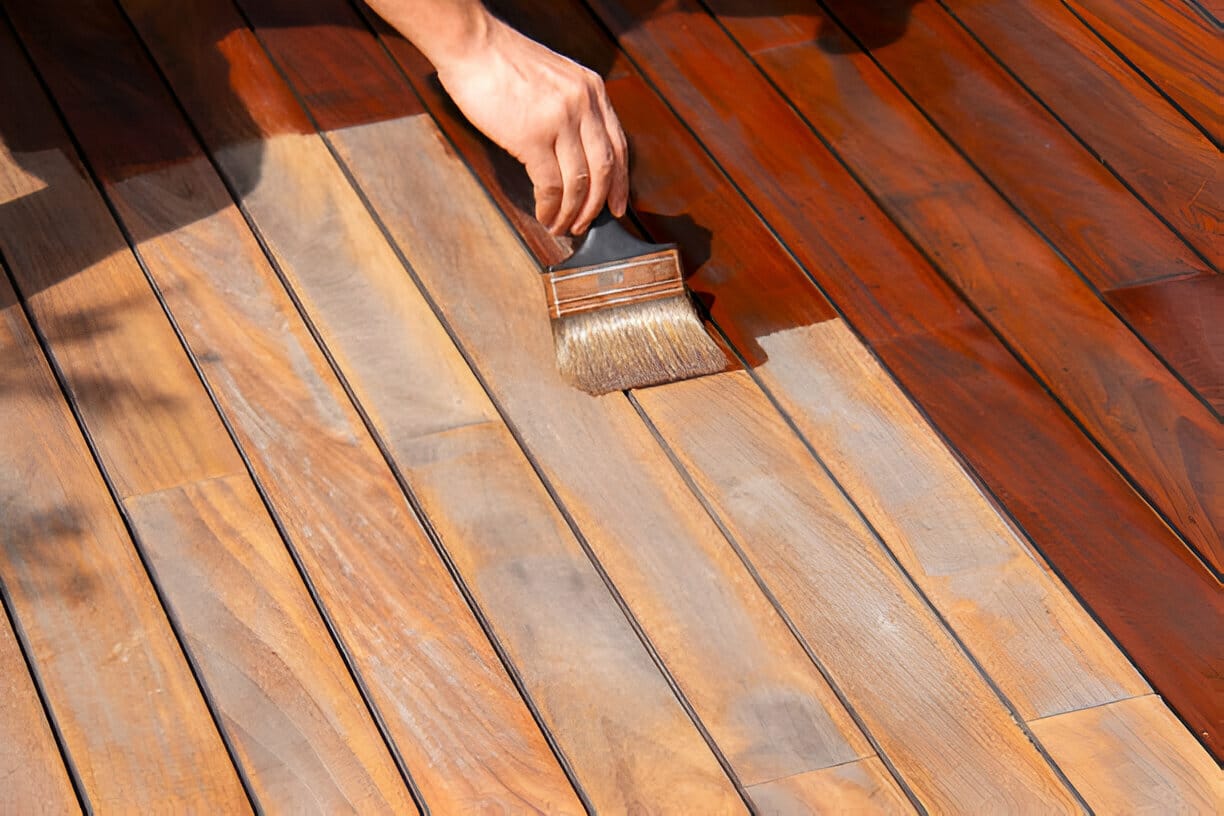
Applying a deck stain is one of the most effective ways to protect and beautify your outdoor space. While many homeowners think of staining as purely cosmetic, it actually serves several critical functions that preserve your deck’s structure and appearance over time.
1. Long-Term Protection from the Elements
Outdoor decks are constantly exposed to harsh weather conditions, especially UV rays, rain, snow, and temperature fluctuations. A quality deck stain sealer creates a barrier that:
-
Prevents moisture from penetrating the wood, reducing the risk of rot and mold
-
Shields against harmful UV rays, which cause fading, discoloration, and the dreaded gray, weathered look
-
Protects from cracking, splitting, or warping that occurs when wood expands and contracts due to climate shifts
2. Enhanced Aesthetics
A fresh coat of deck stain instantly improves your deck’s appearance. Depending on the type of stain and its opacity level, you can either:
-
Highlight the natural wood grain, which is ideal for decks made from high-end materials like redwood or cedar
-
Hide imperfections and old blemishes with a solid-color stain, giving your deck a uniform, freshly painted look
3. Improved Longevity and Value
Staining your deck extends its usable life significantly. By preventing early deterioration, you save on costly repairs and premature replacements. A well-maintained, beautifully stained deck also boosts your home’s curb appeal and overall value—an important factor if you’re planning to sell in the future.
Tip: If you’re already upgrading parts of your home, consider pairing your deck refresh with professional remodeling services for a seamless, high-impact result.
Understanding Deck Stain Types

Before you even open a can of stain, understanding the different types of deck stain is crucial to achieving a long-lasting finish. Each stain type varies in opacity, protection level, maintenance requirements, and visual result.
1. Transparent and Semi-Transparent Stains
These stains are ideal when you want to preserve the natural look of the wood. They allow the wood grain and texture to show through while still offering a basic layer of protection.
-
Best for: New or well-maintained exterior wood, such as pressure-treated pine, cedar, or redwood
-
Advantages:
-
Enhance natural beauty
-
Provide decent UV and water resistance
-
Require more frequent reapplication (every 1–2 years)
-
-
Popular options:
-
Defy Extreme Semi-Transparent Wood Stain (great for UV-rich areas)
-
Cabot Semi-Transparent Stain + Sealer (available in a wide range of wood stain colors)
-
These are a perfect match if you’re looking to showcase the beauty of the natural wood while still giving it some protective qualities.
2. Semi-Solid and Solid Deck Stains
These stains offer deeper pigment coverage and are perfect for older decks or wood with imperfections.
-
Semi-Solid Stains:
-
Slightly more opaque than semi-transparent
-
Still allow some wood grain visibility
-
Offer stronger UV protection
-
-
Solid Color Deck Stains:
-
Opaque and completely hide the grain
-
Excellent for heavily weathered wood or mismatched boards
-
Provide the most robust protection against weather and foot traffic
-
Best for: Older decks, heavily used outdoor spaces, or situations where aesthetics demand a bold, uniform color
These are especially valuable in cases where decks have aged significantly or need a color update. Solid stains also come in modern tones like black deck stain, which is gaining popularity in contemporary outdoor design.
Not sure which to choose? Check out our blog on modern flooring styles that also influence deck stain color choices.
Choosing the Best Deck Stain and Sealer
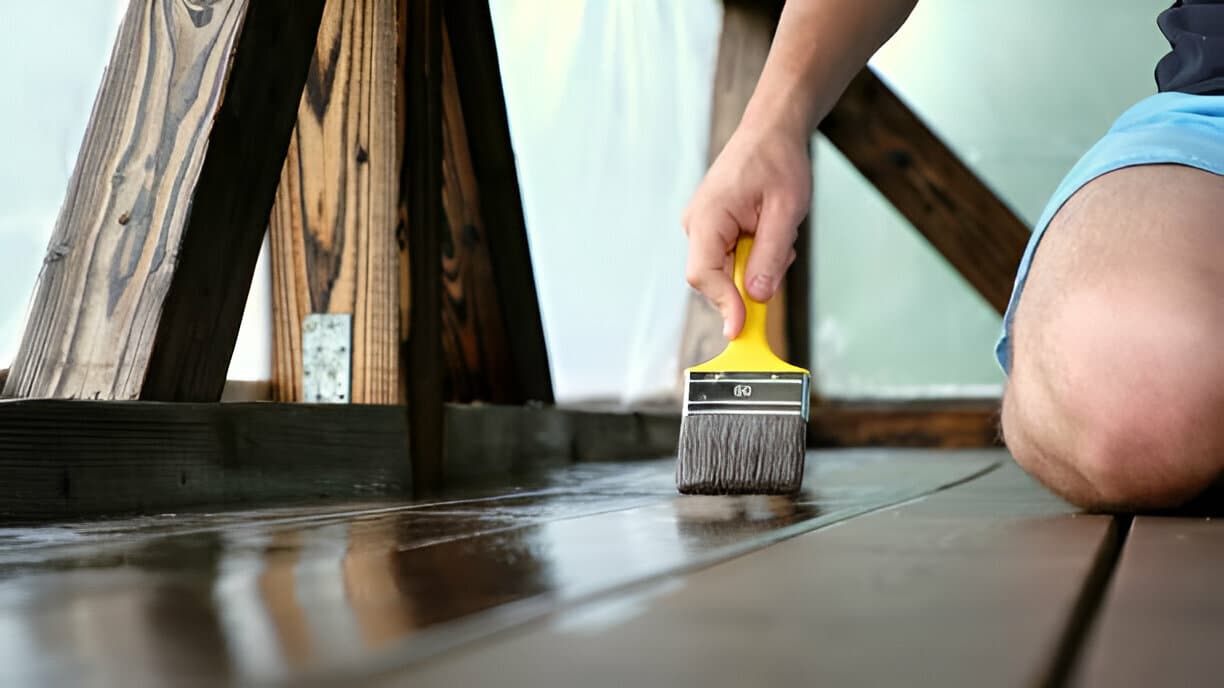
Selecting the best deck stain and sealer isn’t just about aesthetics—it’s about performance, protection, and longevity. With so many products on the market, understanding key differences can help you make a more informed and lasting choice.
Oil-Based vs. Water-Based Deck Stains
One of the most crucial decisions you’ll make is choosing between oil-based and water-based deck stains. Each has unique advantages depending on your needs and the condition of your deck.
-
Oil-Based Deck Stain:
These stains penetrate deeper into wood surfaces, forming a strong barrier against moisture and UV rays. They’re often preferred for older decks or heavily-used outdoor areas, as they provide superior durability and a rich, natural finish. Popular products in this category include Ready Seal, TWP 100 Pro Series, and Cabot Timber Oil. -
Water-Based Deck Stain:
These are easier to apply and clean up, dry faster, and are more environmentally friendly. They form a film on the surface and are less likely to attract mildew. Some high-performance formulas—like Behr Premium Advanced DeckOver—combine excellent coverage with long-lasting protection.
Recommendation: For newer decks and climates with mild to moderate weather, a water-based stain may suffice. For older decks or high-foot-traffic areas, consider the depth and resilience of an oil-based product.
Climate & UV Resistance
The weather in your region plays a major role in determining the best deck stain and sealer for your project.
-
Hot, sunny climates: Opt for UV-resistant or fade-resistant formulas. Look for products like Cabot Gold or Behr Premium Solid Color Waterproofing Stain & Sealer, both of which are engineered to prevent fading and cracking from sun exposure.
-
Humid or rainy regions: Choose a mildew-resistant stain that can withstand moisture and reduce the risk of rot. Products such as DEFY Extreme or Olympic Elite are ideal in damp environments.
For more on protecting outdoor structures from water damage, explore our in-depth guide on waterproofing your home.
Popular Deck Stain Colors and Trends
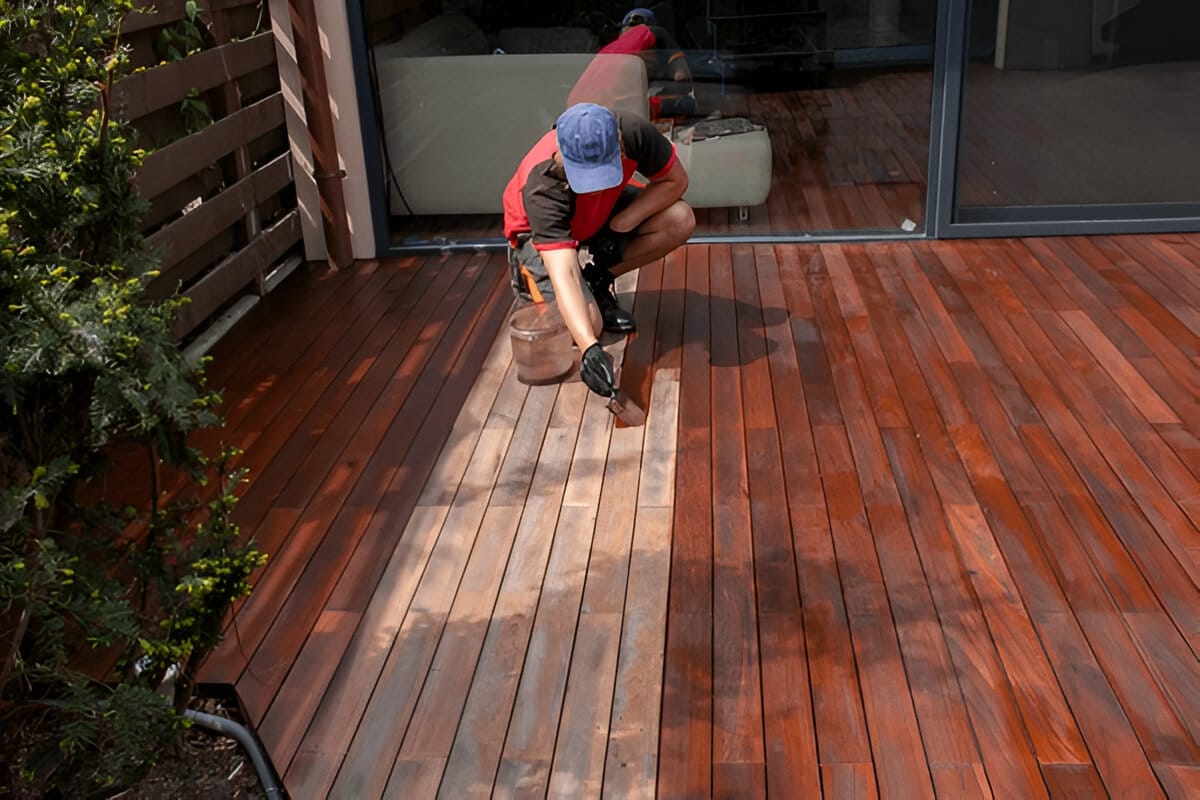
Color selection is more than just a matter of taste—it sets the tone for your entire outdoor area. Whether you’re aiming for a natural look or a bold design statement, the right deck stain color can completely transform your backyard.
Classic Wood Stain Colors
These shades work beautifully with a range of home styles and have stood the test of time.
-
Cedar: Known for its warm, golden tone and rustic charm, cedar stain is ideal for homes with earthy palettes and natural surroundings.
-
Redwood: Bold and rich, this hue is perfect for traditional or craftsman-style homes looking to enhance architectural details.
-
Natural or Clear: Great for showcasing the natural beauty of your wood. These semi-transparent stains allow the wood grain to show through, making them a top choice for premium lumber like redwood or mahogany.
If your deck features high-quality exterior wood, a clear or lightly tinted stain like Cabot Semi-Transparent helps preserve its beauty while adding subtle enhancement.
Trending Exterior Wood Stain Colors
New design trends are bringing fresh color palettes into outdoor living spaces. These modern tones offer a bold update without sacrificing elegance.
-
Black Deck Stain: A daring choice that creates a sleek, modern look—ideal for contemporary homes or decks that serve as outdoor entertaining spaces. Cabot’s Black Solid Stain offers deep color saturation while protecting your deck from the elements.
-
Gray Tones: From weathered driftwood to charcoal, gray is the go-to choice for a neutral yet sophisticated backdrop. These stains pair well with minimalist furniture, steel fixtures, and glass railings.
-
Taupe & Greige: Soft neutral blends like taupe, beige, and greige are becoming increasingly popular for their ability to blend with both cool and warm outdoor palettes.
Looking for even more inspiration? Check out our post on flooring trends and color matching to coordinate your deck with your interior spaces.
Pro Tip: Before committing, test out your chosen color in a small area. Stain shades can vary based on the type of wood, previous finishes, and lighting conditions.
How to Stain a Deck: Step-by-Step Guide
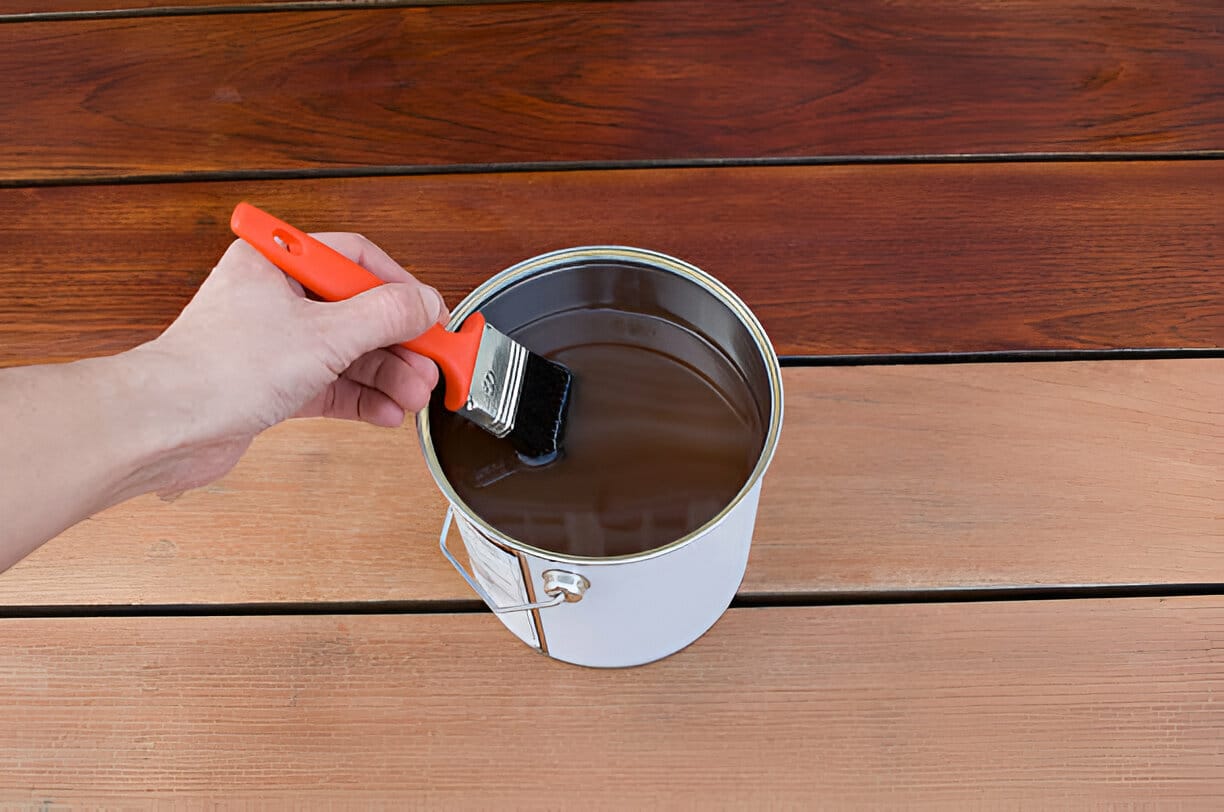
Applying a deck stain correctly is key to achieving a beautiful, long-lasting finish. Whether you’re restoring an old surface or staining a brand-new build, following a systematic process ensures both durability and visual appeal.
Step 1: Prep Your Deck Properly
Preparation is the foundation of a successful deck staining project. Skipping or rushing this step can result in uneven application, poor adhesion, and a finish that won’t last.
-
Clean all wood surfaces thoroughly using a specialized deck cleaner to remove dirt, mildew, algae, and any remnants of old coatings.
-
If your deck has existing stain or sealant, you may need to strip or sand it down to bare wood, especially if switching types of stain (e.g., going from solid to semi-transparent).
-
Inspect for any damaged boards, loose nails, or warped planks and make repairs before continuing.
-
Allow your deck to dry completely—this usually takes 24 to 48 hours depending on weather conditions. Staining damp wood can lead to blotchiness and poor absorption.
Tip: Always check the forecast before staining. Ideal conditions are dry weather, mild temperatures (50–90°F), and low humidity.
Step 2: Choose the Right Tools
Having the right equipment is just as important as choosing the right deck stain. Your tools will affect the speed, consistency, and quality of your application.
You’ll need:
-
A paint pad or roller for large, flat surfaces
-
A natural-bristle brush for cutting in edges, railings, and between boards
-
Drop cloths to protect surrounding areas like siding or landscaping
-
Safety gear: gloves, a dust mask, and safety glasses—especially when using oil-based stains or working in enclosed spaces
Pro Tip: Don’t use foam brushes or low-quality rollers—they can disintegrate and leave residue in the stain.
Step 3: Apply the Stain Carefully
-
Stir your deck stain thoroughly before and during use. Never shake the can—it creates bubbles that can ruin the finish.
-
Start with rails, balusters, and stairs before moving on to the floorboards. These areas are harder to reach and will drip if done afterward.
-
Apply the stain evenly in thin coats, working in manageable sections. Always maintain a “wet edge” to prevent lap marks and streaking.
-
Back-brush where necessary to ensure the stain penetrates the wood surface rather than sitting on top.
-
Avoid puddling—this leads to blotchy patches and extended drying times.
Final Tip: Always test your deck stain color in a hidden corner before committing to the full application. Wood species, previous treatments, and grain density can all impact the final appearance.
If you’d prefer professional help, our experienced team can handle everything—from prep to application. Learn more about our remodeling services or book an appointment for a consultation.
How to Maintain a Stained Deck

Even the best deck stain and sealer can only perform well if it’s properly maintained. Environmental exposure, foot traffic, and seasonal changes all take a toll on your deck over time. Fortunately, consistent upkeep is simple and keeps your deck looking new year after year.
1. Clean Regularly
Dirt, pollen, leaves, and moisture can build up on your deck and break down the stain over time. Use a mild detergent or specially-formulated wood cleaner every few months, particularly in spring and fall.
-
Avoid power washers—they can strip the stain if used improperly.
-
Use a soft brush or broom to scrub high-traffic areas.
2. Reapply Stain Every 2–3 Years
Even the highest-quality deck stains wear out eventually. Monitor your deck for signs of fading, water absorption, or patchiness. If water stops beading on the surface, it’s time to re-stain.
-
Semi-transparent stains may require reapplication every 2–3 years.
-
Solid deck stains often last up to 5 years but may still need touch-ups in worn areas.
3. Spot-Treat High-Use Areas
Steps, doorways, and gathering spots tend to wear faster. These can often be re-coated without redoing the entire deck, especially if you’ve used a stain and sealer combo.
-
Clean and lightly sand the area first for even blending.
-
Match the existing wood stain color and apply in thin coats.
4. Use Dual-Function Stains
Save time and effort by choosing a product that functions as both a deck stain and sealer. These hybrid formulas simplify maintenance and reduce the need for multiple coats or products.
For longer-term preservation, explore our blog on waterproofing your home, where you’ll find expert tips on protecting outdoor structures.
Hiring Deck Staining Professionals
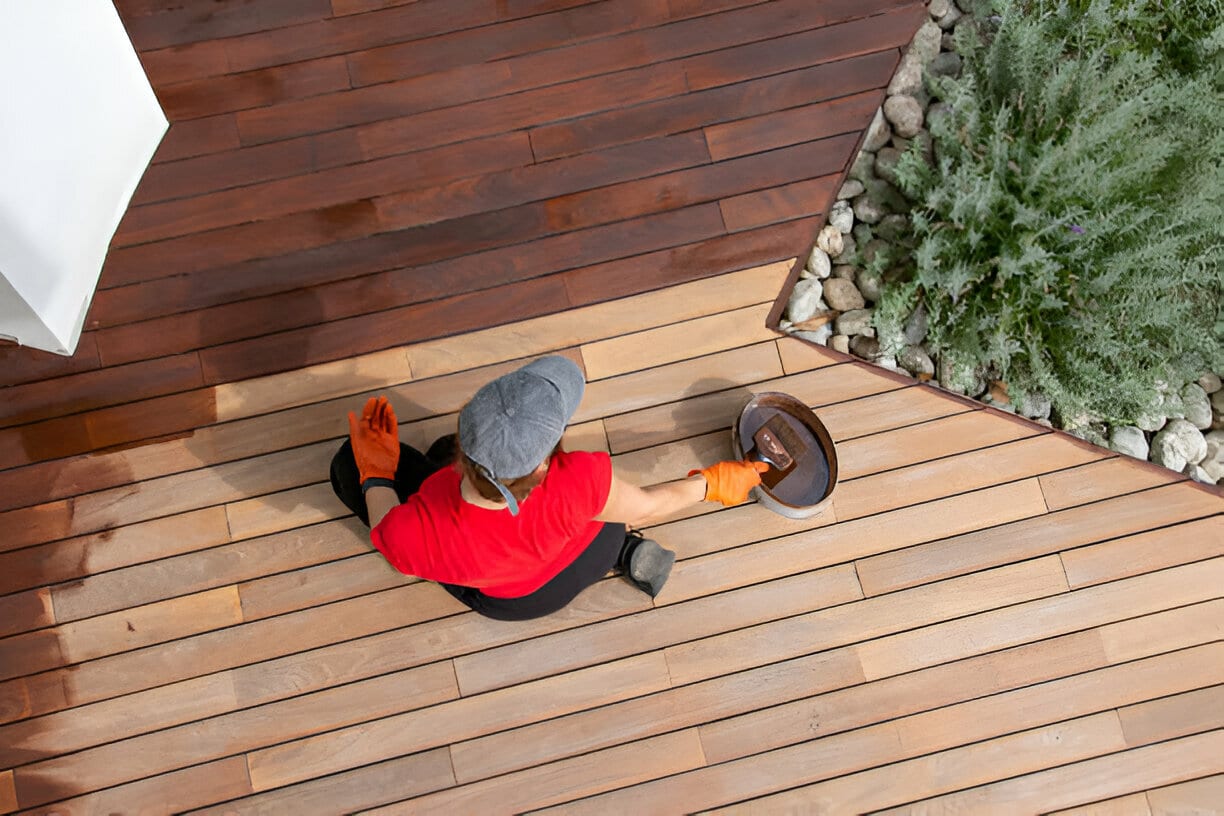
Searching for deck staining near me? While staining a deck can be a manageable DIY project for some homeowners, hiring experienced professionals ensures a smooth, uniform finish—especially for larger or more weathered decks.
Here’s what to look for when hiring deck staining companies:
-
Experience with Your Type of Wood
Whether your deck is made from pressure-treated pine, cedar, redwood, or tropical hardwoods, your contractor should understand how different types of wood respond to various types of stain. Each wood species absorbs stain differently, which can affect both protection and appearance. -
Expertise in Stain Opacity and Application
A seasoned pro will know when to use solid color deck stains versus semi-transparent stains, depending on your deck’s age, condition, and the desired look. They’ll also use the right techniques—like back-brushing and wet-edge blending—to ensure even coverage. -
Licensed, Insured, and Backed by Warranty
Choose contractors who offer clear warranties and have solid reviews from past customers. Reliable providers will stand by their work and offer touch-ups or re-coats if needed.
At VCT Kitchen and Bath, we collaborate with a network of vetted, trusted deck staining professionals. Whether you need a simple refresh or a full restoration, our partners bring expert knowledge and premium products to every job. Explore our remodeling services to see how we can assist with additional home upgrades.
Frequently Asked Questions About Deck Staining
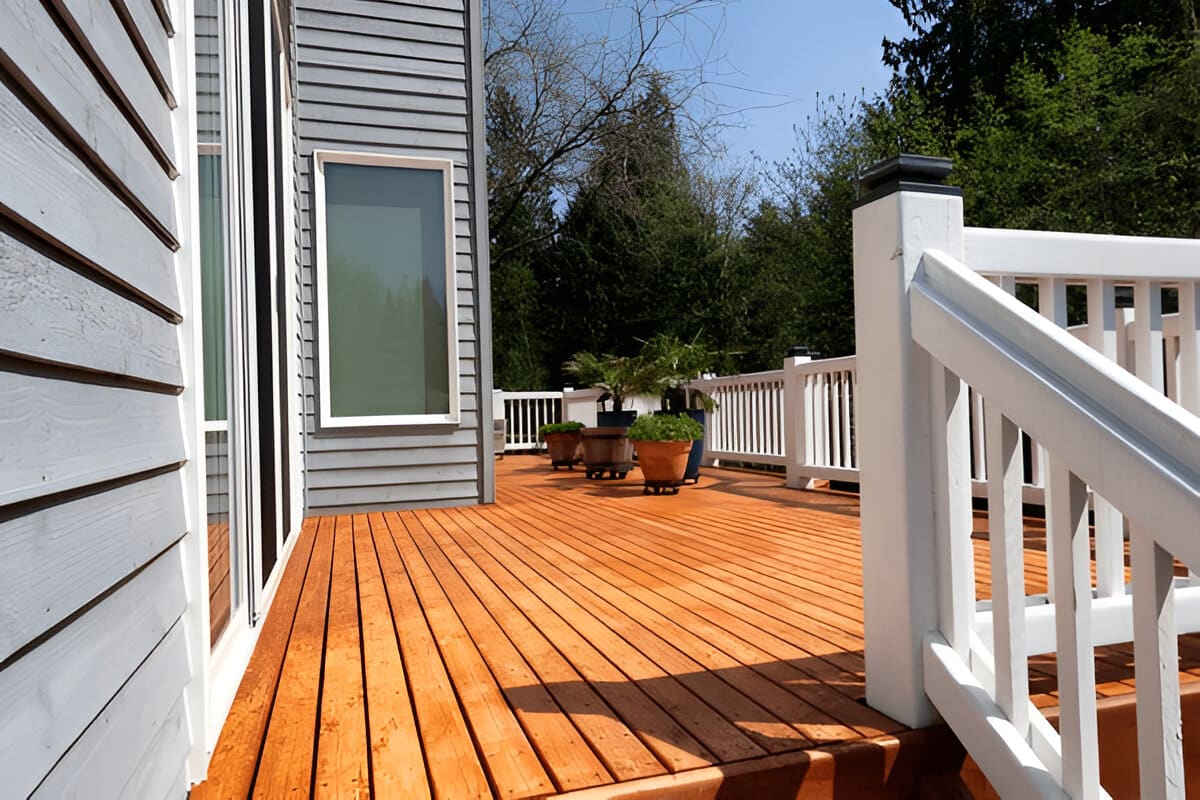
How long should I wait after it rains to stain my deck?
Before applying any deck stain, ensure that the wood is completely dry. Moisture trapped beneath the stain can prevent proper adhesion, leading to peeling and uneven coverage.
-
Wait at least 24–48 hours after rainfall, or longer in humid conditions.
-
Use a moisture meter to confirm that the wood’s moisture level is below 15% for oil-based stains and 12% for water-based stains.
Can I stain over an old deck stain?
Yes, but it depends on the condition of the existing finish and the type of stain previously used.
-
If you’re reapplying the same opacity (e.g., solid over solid), a light cleaning and sanding might suffice.
-
If switching from a solid deck stain to a semi-transparent product, the old finish must be removed entirely to expose the bare wood and allow penetration.
-
Always test a small area before committing to a full recoat.
How do I choose between Cabot deck stain and other brands?
Cabot deck stain is one of the most respected names in the industry—and for good reason. It’s known for:
-
A wide range of wood stain colors, including traditional, modern, and custom-mixed hues
-
High-quality options across the opacity spectrum: semi-transparent, semi-solid, and solid stains
-
Specialized formulas like Cabot Semi-Solid Acrylic Siding Stain and DeckCorrect™, designed for older decks with cracking, splintering, or uneven wear
Compared to other leading brands such as Behr, Olympic, or DEFY Extreme, Cabot is often praised for its deep penetration, color longevity, and superior coverage. If you’re unsure which formula suits your needs, consult with one of our experts or visit the Cabot product overview to explore more options.
Source Links
-
Home Depot – Deck Staining How-To
https://www.homedepot.com/c/ah/how-to-stain-a-deck/9ba683603be9fa5395fab90de38c905 -
Cabot Stain – Browse Exterior Colors
https://www.cabotstain.com/en/opacity-color/browse-colors -
Brad the Painter – Best Deck Stain and Sealer
https://www.bradthepainter.com/best-deck-stain-and-sealer/ -
Consumer Reports – Best Wood Stains of 2025
https://www.consumerreports.org/home-garden/wood-stains/best-wood-stains-from-consumer-reports-tests-a4478428531/ -
Sherwin-Williams – Shop Deck Stains by Project
https://www.sherwin-williams.com/homeowners/products/shop-by-project/deck-stains -
Behr – Exterior Wood Stain Colors
https://www.behr.com/pro/colors/wood-stain -
Olympic – How to Stain a Deck for First Timers
https://www.olympic.com/advice/how-to-stain-deck-first-timers-guide -
DeckStainHelp.com – The 5 Best Deck Stain Reviews
https://www.deckstainhelp.com/the-5-best-deck-stain-reviews-and-ratings/


